COATS
OF ARMS OF THE
POPES
OF ROME
Return 2
â
Nrs 230-257
b
|
Papal residence in Rome 1376 - |
|||||||||||
|
230 Pius IV |
1559-1565 |
||||||||||
|
Foto H.d.V. 5.V. 2005 The arms of Pius
IV on the ceiling of St. John Lateran, Rome Giovan-Angelo
Medici was the son of Bernardino Medici, a Milanese tax-contractor, and of Cecilia
Serbeoni; his suster was the mother of St Charles Borromeo and his brother
was the famous Gian-Giacomo, known as the Medichino and as the Castellan of
Musso, who ultimately bacame marquess of Marignano. His family which had no
connection with the Medici of Florence, though both had a similar if quite
independent origin, appears in Milan in the 13th century. The
arms of the Milanese Medici appear in the Trivulzio book of arms [1]) (15th
century) as, Gules a roundel Or, and these same arms can be seen under a
chief of the Empire on coins struck in 1523 by Gian-Giacomo as marchio mussi, comes leuci (Lecco). After 1549 however, when Paul III
made one of the brothers a cardinal, and married the other one to Marzia
Orsini, Gian-Giacomo began to use the arms of the Florentine Medici and the
seals of his letters now at the Milan State Archives show a shield with the
six palle but with the chief of the Empire from his original coat.
Similar arms appear on the seal of Giovan-Angelo in 1551, and on that of
Agosto Medici in 1554. Whether Giovan-Angelo dropped the chief of the Empire while still a cardinal is not certain, but as Pope he used nothing but the Florentine Medici coat including even the augmentation of the three French lilies. His arms appear in this form on the Palazzo dei Giuriconsulti at Milan, on the Porta Pia in Rome and in St John Lateran, as well as on his coins, though on his monument in Santa Maria degli Angeli we find the Florentine coat with the six red palle but without the fleur-the-lis augmentation. The genuine Milanese coat with the single golden ball had thus been entirely dispensed with, and the later Medici of Marignano continued to bear the Florentine coat with the French augmentation. The Medici of Florence can be said to have tacitly agreed to, if not connived at, this substitution by acknowledging the Milanese family as cousins after their rise in the world.
Coin of Gian-Giacomo Medici, “Marquess of Musso, Count of Lecco” (Æ 16 mm ca)
(Foto H.d.V. I.2000) Coat of arms of the Milanese Medici family
between the coats of arms of some Visconti family members in the Museo
Sforzesco, Milan. |
|||||||||||
|
231 Pius V |
1566-1572 |
||||||||||
|
Antonio
Ghislieri, son of Paolo Ghislieri, and of Domenica Algeri, was born at Bosco,
near Allessandria, of a humble family originally from Pinewrolo in Piedmont,
but settled at Bosco since 1366. He
took the name Michele upoon entering the Dominican Order. The arms
botne by Pius V, Bendy gold and gules, are those of a totally different Ghislieri family of
Bologna. They may be seen on the ceiling of St Johm Lateran, on the façade of
Santa Maria sopra Minerva, and on the Pope’s tomb at Santa Maria Maggiore.
Foto H.d.V. 11.94 The arms of Pius
V on the ceiling of St. John Lateran, Rome Arms: Bendy of six Or and Gules Crown and crest: A Tiara and keys in saltire |
|||||||||||
|
232 Gregorius XIII |
1572-1585 |
||||||||||
|
Ugo
Buoncompagni was the son of Cristoforo Buoncompagni and of Angela Maresclchi. The
Buoncompagni family descend from Pirreno, son of Giovanni, who belonged to
the council of Bologna at the end of the 14th century, but the owe their rise
to Gregory XIII. Their arms, Gules a demi-dragon gold, appear on the Pope’s
monument in St Peters’s and on his coins, medals and portraits.
Achievement of Gregorius XIII Arms: Gules, a dragon issuant dimidiated Or Crown and crest Supporters: D.:
A man armed with a sword and a lion; S.: A lady with a staff and a
serpent.
The arms of
Gregorius XIII on the ceiling of St. John Lateran, Rome |
|||||||||||
|
233 Sixtus V |
1585-1590 |
||||||||||
|
Felice di Peretto Ricci, son of Pietro detto
Peretto of Maontalto and of Marianna N……, belonged to a family which appeared
in the public affairs of Montalto in
the 15th century. Felice when Procurator-General of the Franciscan
Order had already dropped the name of Ricci for that of Peretti, and his
sister Camilla also preferred to call herself “de Peretti.” Sixtus
V’s arms, Azure a lion holding a branch of a pear-tree Or, and a bend Gules over all, charged with a molet Or in
chief, and a triple mount Argent in base, can be seen in any part of
Rome, for the amount of building done by him during his five years’Pontificate
is prodigious. The story that Sixtus when cardinal added the star, pear-tree
and mlunts to his original arms, is most improbable
Arms
of Cardinal Felice Peretti (the later Pope Sixtus V)[2] .
The achievement of Pope Sixtus V depicted in the
Vatican Library Arms: Azure a lion holding a branch of a pear-tree Or,
and a bend Gules over all, charged
with a molet Or in chief, and a triple mount Argent in base Crown and crest: A Tiara and keys in saltire supported by
two putti Supporters: D.: Pietas with a chalice with wafer and a
cross S.: Justice with sword and balance |
|||||||||||
|
234 Urban VII |
1590 |
||||||||||
|
Giovanni-Batista Castagna was the son of Cosimo
Castagna of Genoa and of Costanza Ricci, and came from an old and important patrician family. His arms, Bendy
silver and gules, a chief gules upheld by a fillet gold and charged with a
chestnut bur slipped and leaved gold, may be seen on his monumant in
Santa Maria sopra Minerva
Arms: Argent,
three bends Gules, a chief Argent charged with a rose Gules and sustained by
a fillet Or, charged with an eel Azure
(Orsini); (Per fess, a fess Vert, a fess wavy Argent; in
chief Gules a branch of rose flowering proper; in base bendy Argent and Gules
of seven), Crown and crest: A Tiara and keys in saltire |
|||||||||||
|
235 Gregorius XIV |
1590-1591 |
||||||||||
|
Niccolo
Sfondrati was the son of Francesco Sfondrati and of Anna Viscont. The
Sfondrati were one of the principal families
of Cremona to which city they have given no less than twenty-six decuriones between 1152 and 1668 the
year of their extinction. Gregory’s
arms Quarterly, first and fourth, gold
a bend battled on both sides azure, charged with a bendlet silver, between
two molets of eight points azure, second and third, silver a tree uprooted
vert, appear on his coins and medals, and in the Casino of Pius IV in the
Vatican. The bends are sometimes drawn continuously across the shield. Not
infrequently they are ragged instead of battled
Arms: Quarterly: 1&4: Or, a bend embattled
counter-embattled Azure charged with a bendlet Argent; 2&3: Argent, a
tree on a ground Vert. Crown and crest: A tiara and two keys in saltire supported
by two putti Supporters: Justitia and Victoria |
|||||||||||
|
236 Innocentius IX |
1591-1591 |
||||||||||
|
Gian-Antonio
Facchinetti was born at Bologna but his family originall came from te village
of Cravegna in the Val dÁntigorio near Domodossola. His grandfather, Navarino
della Noce or di Nocetti, lived at Cravegna, but the Pope’s father, Antonio,
marries Francesca Cini of Croveo, in a nearby village, and cam to Bologna in
1514 where he worked as a facchino
(whence the name Facchinetti borne by his descendants). Innocent
IX’s arms, Silver a nut three uprooted
vert, seem to appear only on his medals and on his coins.
Arms: Argent a Nut-tree proper Crown and crest: A tiara and two keys in saltire supported
by two putti Supporters: Justitia and Victoria |
|||||||||||
|
237 Clemens VIII |
1592-1605 |
||||||||||
|
Ippolito
Aldobrandini was the son of a consistorial advocate, Salvestro Aldobrandini,
and of Lisa Dato. He belonged to a family which appeared in Florence in the
13th century. The
Aldobrandini arms, Azure, a bend battled on both sides Or between six
molets of eight points Or, are frequently to be seen in Rome. Fine
examples of them exist on the ceiling of St. John Lateran and of the Sala del
Consistorio of the Vatican as well as on the Pope’s monument in Santa Maria
Maggiore.
Arms of
Hippolyt Aldobrandini of Florence, Cardinal, 1585; Pope Clement VIII., 1605,
engraved by Agostino Carraci, born at Bologna 1558, died at Parma 1601. The
coat of arms is: Azure, a bend embattled and counter-embattled between six
six-pointed stars in bend, three and three or.[3])
Foto H.d.V. 05.05.2005 Arms of Pope
Clement VIII on the ceiling of St. John Lateran, Rome. Arms: Azure, a bend embattled counter embattled
between six eight-pointed stars 3 and 3. Or |
|||||||||||
|
238 Leo XI |
1605-1605 |
||||||||||
|
Alessandro
de’ Medici, son of Ottaviano de’ Medici and of Francesca Salviati niece of
Leo X, beloged to a branchof de Medici family which ultimately bore the title
of Princes of Ottaiano. Leo IX’s arms
are the same as those of Leo X and of Clement VII, and can be seen on his
monument in St Peter’s and on the base of his statue in te cathedral of
Pistoja.
Arms of Pope Leo XI Archbishop’s palace Florence (www. picturesfromitaly.com) |
|||||||||||
|
239 Paulus V |
1605-1621 |
||||||||||
|
Camillo
Borghese was a son of Antonio Borghese of Siena and of Flaminia Astalli of
Rome. The
arms of Meo di Toto Bordighesi, one of the asghuitori of the Gabella in 1479, Azure a dragon with raised wings gold, appear on the painted
cover of that years’s tax-book in the Siena State Archives. About 1530 some
of the family, including the Pope’s branch, added a chief of the Empire (gold an eagle sable) to teir coat, of
which the eagle is in some cases depicted risng with silver feet and sable
beak. (teh mosaic of Paul V’s arms in the Confession of St Peter’s).
Arms: Azure, a dragon Or and a chief Or, an
crowned eagle Sable Crown and crest: A Tiara and keys in saltire Supporters: Two angels |
|||||||||||
|
240 Gregorius XV |
1621-1623 |
||||||||||
|
Alessandro
Ludovisi was the son of Pompeo Count Ludovisi and of Camilla Bianchini. The
Ludovisi, and old and noble family of Bologna to which belonged Gionanni Ludovisi
senator of Rome in the 14th century, became extinct in th 15th, and the name
and arms were assumed by the descendants of Ludovico di Monterenzi whom the
last representative of the Ludovisi had adopted in 1470. These arms,
generally blazoned, Gules three bends silver reytaist in chief, were
doubtless originally Gules a chief bedy silver and gules. The second Ludovisi
family became extinct in 1701 and the name and arms were then assumed by the
Boncompagni. Gregory XV’s arms can be seen on his coins and official
publications , on his tomb in Sant’Ignazio. and on the façade of the modern
Palazzo Margerita, originall Boncompagni-Ludovisi, where the three Ludivis
bends ans the Boncompagni dragon alernte below the windows.
Arms of Gregory XV on his tomb in the Sant’Ignazio By Pierre Le Gros the Younger (1666-1719) Arms: Gules, a chief bendy of seven Gules and
Argent Crown and crest: A Tiara and keys in saltire Supporters: Three putti. |
|||||||||||
|
241 Urban VIII |
1623-1644 |
||||||||||
|
Maffeo Barberini, son of Antonio Barberini of
Florence and of Camilla Barbadoro, belonged to a family whose name had
originally been Tafani da Barberino. The
Tafano only came into prominence in 1490 when one of them was elected Prior,
and Urban VIII thought it worth while to have the second edition of Verino’s De
Illustratione Urbis Florentiæ doctored by skilfully shifting some lines,
so as to apply to his own family the greater part of the panegyric of the
Neri da Barberini. The
Tafani da Barberino bore, Gules, three horse-flies (tafani) Or.
Later the horse-flies became bees, and, apparently in the middle of the 16th
century, the tinctures were changed to azure and Or. Still the original
tinctures occasionally appear as for example on the monument of the Pope in
St Peter’s.
Santa Maria in Aracoeli, arms of Urbanus VIII Arms: Azure three bees proper (Or) 2 & 1. |
|||||||||||
|
242 Innocentius X |
1644-1655 |
||||||||||
|
Giovanni-Battista Pamphili was the son of Camillo Pamphili
and of Flaminia di Bubalo-Cancellaria, and belonged to a family which appears
in Gubbio in the 14th century. The branch of the Pope, which in
1760 became extinct in the Doria family, descends from Antonio Pamphili who
went to Rome and became fiscal to Pope Innocent VIII. To
the herald, the Pamphili arms with their curious chief present a problem in
blazoning. The best reading is probably, Gules, a dove Argent holding an
olive-branch Vert, and a chief azure charged with three fleurs-de-lis Or
divided by two pallets retraits in base Gules. Originally this chief was
doubtless nothing but the chief of Anjou, capo d’Angiò, so frequently
to be seen on the coats of Guelph families; such a shield of the Pamphili
arms dating from the 15th century may be seen in the museum at
Perugia. A tombstone of 1600 in San Pietro in Montorio seems to indicate that an alternative and certainly older version showed the chief Azure sustained by an inverted label of four points and charged with three fleurs-de-lis Or. Several curious examples of Innocent X’s arms are to be found in the Raccolta di varie targhe di Roma of Fil. Juvarra, Rome, 1711.
Foto H.d.V. 4.V.2005 Arms of Innocent X
at the fountain on the Piazza Navona, Rome
Arms of Innocent X. Museum of the Vatican Arms: Gules, a dove Argent with an olive branch
Vert and a label of three Azure charged with three fleurs de lys Or. Crown and crest: A Tiara and keys in saltire |
|||||||||||
|
243 Alexander VII |
1655-1667 |
||||||||||
|
Fabio Chigi, son of Flavio Chigi and of Laura Marsete, belonged to a Sienese family descended from Alemanno (ca. 1277) whose grandson Chigio gave his name to his house. Alexander
VII bore at times only the Chigi arms, Gules, a molet of eight points Or,
on a sextuple mount Or, and at
others a quartered coat with the Rovere arms in the first and the fourth
quarters. The Rovere augmentation had been granted in 1507 by Julius II to
his banker and confidant Agostino Chigi il Magnifico, whose branch, after
losing its fortune and leaving Rome, became extinct in 1580; Alexander VII
was descended from Agostino’s younger brother Sigismondo. Both types of his
arms are to be seen on the colonnade of St Peter’s. At Santa Maria del Popolo
Alexander has also placed the tiara and keys in chief of his quartered
shield, probably in order to imitate some of the achievements of the Rovere
Popes.
Foto H.d.V. 1.V.2005 Achievement
of Alexander VII in the S. Maria del Popolo in Rome |
|||||||||||
|
244 Clemens IX |
1667-1669 |
||||||||||
|
Giulio
Rospigliosi was the son of Girolamo an Caterina Rospigliosi of Pistola. The
Rospigliosi appear in Pistoja in the 13th century and produced several famous
condottieri in the 15th and 16th. Their arms, quartely gold and azure, four lozenzes
counterchanged, appear on Clemts IX’s coins and medals and on his monuments
in Santa Maria Maggiore.
Quarterly Or and Azure four diamonds
counterchanged |
|||||||||||
|
245 Clemens X |
1669-1676 |
||||||||||
|
Emilio Altieri,
son of Lorenzo Altieri and of Vittoria Delfini of Venice, was tha last amel
descendant of a Roman family which had been of some importance since the 15th
century. Their name and arms, Azure six
molets of eight points siover, and a border indented silver and azure
were taken over by the Albertoni-Paluzzi, one of whom married the Pope’s
niece. Fine
examples of Clement X’s arms are to be
seen on the mosaic pavement of the atrium of St Peter’s, on the Pope’s
monuments wihin the church, and on the Altieri palace in Rome. The indented
border is not infrequently forgotten.
Coat of arms of Pope Clement X (r. 1670-76), Palazzo
Altieri Arms: Azure six eight-pointed stars Argent 3.2 and
1 and a bordure per pale indented Azure and Argent
Fresco in Spoleto Castle |
|||||||||||
|
246 Innocentius XI |
1676-1689 |
||||||||||
|
Benedetto Odescalchi was the son of Livio
Odescalchi and of Paola Castelli of Como. The Odescalchi, who had appeared in
Como in the 13th cedntury, became extinct in the persons of Livio
Odescalchi Duke of Syrmia and
Bracciano (†1713) and of his sister Lucrezia wife of Allessandro Erba, whose
second son took the name and arms of his mother’s family.
The Odescalchi arms, Argent, three bars gules
accompanied by a lion passant in chief and six (3,2,1) cups all Gules, with a
chief of the Empire, probably consisted originally of a coat of vair papelonné
with a lion in chief, but the cups appear as early as 1485 in the book of
Comasque arms, formerly the property of Count Cavargna di San Giuliano and
now in the Museo Civico of Como. (Galbreath, 99)
Arms of Odescalchi family |
|||||||||||
|
247 Alexander VIII |
1689-1691 |
||||||||||
|
Pietro
Ottoboni was the son of Marco Ottoboni and of Vittoria Tornielle of Venice.
In the 16th and 17th centuries three members of the Ottoboni, including the
Pope’s father, rose to the position of Grand Chancellor of the Republic, the
highest position open to a non-noble, and in 1648 Alexander’s father was
admitted to the nobility on payment of 100,000 ducats. The family became
extinct in 1725 when the name and arms passed by marriage to a branch of the
Boncompagni-Ludovisi, now also extinct, whose heiress carried the name and
arms in 1921 to a branch of the Rasponi family. Alexander
VIII’s arms, Part bendwise azure and vert, a ben gold and a chief gold with a
double-headed eagle sable, may be see on his coins and on his tomb in St
Peter’s.
Coat of arms of Pope Alexander VIII (r. 1689-91),
Fontana dell' Acqua Paola Arms: Parted per bend Azure, and Vert , a bed Or,
and a chief Or, a crowned two-headed eagle Sable Crown and Crest: A tiara and two keys in saltire. |
|||||||||||
|
248 Innocentius XII |
1691-1700 |
||||||||||
|
Antonio
Pignatelli, born at Spinazzola in the Basilicata, was the son of Fabrizio
Pignatelli Prince of Minervino and Marquess of Spinazzola and Porzia Carafa
daughter of the duke of Andria. The
Pignatelli, one of the oldest baronial families of the kingdom of Naples, are
still in existence although the Pope’s branch became extict at his death. A very
fine example of Innnocent XIIs’arms, Gold
three jugs (pignate) sable, is
to be seen in he Baptistery Chapel in St Peter’s. The two upper jugs are set
facing each other
Arms of Innocentius XII Arms: Or, three jugs Sable 2 & 1. Crown and Crest: A tiara and two keys in saltire |
|||||||||||
|
249 Clemens XI |
1700-1721 |
||||||||||
|
Gianfrancesco
Albani, son of Carlo Albani senator of Rome and of elena Mosca of Pesaro, was
born at Urbino in 1649. There is no cause to connect with the older Bergamo
house of the same name this Urbino family whichowes its rise to the Pope’s
uncle Orazio Albani, made senator of Romein 1633 as a reward for his success
in arranging the transfer of the duchy of Urbino to the Holy See. The
Albani arms, frequently to be seen in Rome, are, Azure, a fess between a molet of eight points in chief, and a
triple mount in base, all gold; the mounts are not infrequently drawn as
rocks, as for instance in the ceiling of San Clemente in Rome.
Coat of arms of Pope Clement XI (r. 1700-21), Arms: Azure, a fess, an eight-pointed star in chief
and a triple mountain in base Or. Crown and Crest: A tiara and two keys in saltire |
|||||||||||
|
250 Innocentius XIII |
1721-1724 |
||||||||||
|
Michelangelo
Conti, the eldest son of Carlo Conti Duke of Poli and of Isabella Muti, was born
in Rome in 1655 and belonged tot he same Roman house as Innocent III,
Gregorry IX, and Alexander IV. Innocentt
XIII’s arms, Gules an eagle checky gold
an sable, crowned and armed gold can be seen in the court of the hospital
of San Spirito in Rome, and on a fine mosaic pavement in the castle of Sant’
Angelo. The Pope’s tomb in the Grotte Vaticane shows only the Conti eagle
engraved on the tombstone.
Achievement of Innocentius XIII Palazzo nel Commendatore,
Rome Arms: Gules a crowned eagle chequy Sable
and Or. Crown and crest: A Tiara and two keys in saltire, Supporters: Two putti and allegories of Love and Justice |
|||||||||||
|
251 Benedictus XIII |
1724-1730 |
||||||||||
|
Pier-Francesco Orsini was born in 1649 and was the
eldest son of Ferrante Orsini Duke of Gravina, a branch of the great Roman
house to which had belonged Coelestine III and Nicholas III, are descended
from Francesco Orsini Count of Trani and Conversano, first Duke of Gravina,
and prefect of Rome in 1495. The futrure Pope succeeded as Duke of Gravina in
1660, but in 1668 he resigned his fiefs and titles in favour of his younger
brother, and entered the Domincan Order under the name of Vincenzo-Maria.
Benedict XIII’s arms are: Parted per pale, dexter
Argent, three bends Gules, a chief Argent charged with a rose Gules and
sustained by a fillet Or, charged with
an eel Azure (Orsini); sinister, Azure, a tower Argent (Gravina); a
chief of the Dominican Order, chapé Sable and Argent, in base a dog spotted
Argent and Sable couched holding a lighted torch in his mouth and his paws
lying on a bool, surmounted by a palm branch and a branch of lilies crossed
in saltire all proper and passed through a crown Or, in chief a molet of
eight rays Argent. The eel in the Orsinis coat is supposed to represent
the county of Anguillara, which however never belonged to the Gravina branch,
but it seems to have been originally merely a decorativeline similar to the
one in the Savelli shield. Benedict XIII’s arms may be seen on his coins and
on his engraved portraits. |
|||||||||||
|
252 Clemens XII |
1730-1740 |
||||||||||
|
Foto H.d.V. 03.05.2005 Arms of Clement XII on the Trevi-fountain in Rome Lorenzo Corsini, son of Bartolomeo Corsini and of Isabella
Strozzi, was born in Florence in 1652. His family, which had given seven
gonfaloniers and forty-nine priors to Florence, had been one of the most
prominent in the city since the 13th century and is still
flourishing. Fine
examples of the Pope’s arms, Bendy Argent and Gules, a fess Azure, are
to be seen on the façade of the Consulta and in te pavement of the atrium of
St. John Lateran. |
|||||||||||
|
Foto
H.d.V. 08.05.2005 Arms of
Clemens XII on the façade of St. John Lateran |
|||||||||||
|
254 Benedictus XIV |
1740-1758 |
||||||||||
|
Coat of arms of Pope Benedict XIV (r. 1740-58),
Triclinium of Pope Leo III Prospero Lambertini was born at Bologna in 1675
and was the son of Marcello Lambertini, a senator of the city, and of Lucrezia
Bulgarini. His family appears in Bologna in the 13th century. Benedict XIV’s arms are Or, four pales Gules,
but frequently only three pales are shown, as is the case on the Fontana di Trevi
and in the frescoes of the vatican Library. On some of his coins the family
coat is said to be impaled with the complete arms of Benedict XIII, to whom
he owed his elevation to the cardinalate, thus showing the most elaborate
coat borne by any Pope, as illustrated in a German armorial of 1746.
His larger arms On the dexter the arms of
his predecessor Benedict XIII |
|||||||||||
|
255 Clemens XIII |
1758-1769 |
||||||||||
|
Carlo Rezzonico,
son of Giambattista Rezzonico Count della Torre and of Vittoria Barbarigo,
was born in Venice in 1693. He beonge
to an old and noble family of Como of which a branch, sttled in Venice
in the 16th century, was recieved into the Venetian patriciate in 1687. In the
15th-century book of Comasque arms, now in teh Como Museum, the original arms
of the family, with the name “de Reconico,” appear as, Silver, a tower azure within a border gobony azure and silver, and a
chief gold with an eagle sable. The arms granted in 1665 to a Como branch
with a patent of braon of the Empire, which the Pope also bore, were, Quarterly, first gules, a cross silver,
second and third, azure a tower slver, fourth, gules three bends sinister
silver; over all a scutcheon gold with a two-headed crowned eagle sable, the
scutcheon surmounted by a coronet. Clement
XIII’s arms appear not infrequently in Rome, for instance above the gate of
the Palazzzo dell’Annona.
Arms of Clemens XIII Palace of the Quirinale,
Rome
Arms of Clemens XIII embroidery on his chasuble Arms: Quarterly: 1. Gules, a cross Argent;
2&3: Azure, a tower Argent; 4. Bendy Argent and Gules of eight pieces.
And an escutcheon crowned with an antique crown in nombril point Or, a
two-headed eagle Sable. |
|||||||||||
|
256 Clemens XIV |
1769-1774 |
||||||||||
|
Giovanni-Vincenzo-Antonio
Genganell (in religion Lorenzo-Francesc) was bron at SantÁrcangelo near
Rimini in 1705 and was the son of a doctor of medicine, Lorenzo Ganganelli, and
of Angela-Serafina Mazza, also of a medical family. The Ganganelli apear in
Borgo Pace at the end of the16th century, but LorenzoGanganelli became a
burgess of Sant’Arcangelo in 1710, and, when a cardinal, his son the future
Pope, was enrolled among the nobility of Rimini. To his
paternal coat, Azure, a fess gules
between three molets of six points gold in chief, and a triple mount gold in
base, Ckement XIV added a chief of
the Order of St Francis, silver, a long cross proper, over all two arms
crossed in saltire, one nude, the other clad as that of a Franciscan friar
both hands with the stigmata, all proper. When the
field of the chief is azure, as is not infrequently the case, the chief is
sometimes delineated by fillet gold.
Arms:Azure, a fess Gules, in chief three
eight-pointed stars and in base a triple mound Or; And in a chief Azure
issuant from te clouds a dressed arm, a latin cross per pale and a naked arm
with their stigmata in saltire proper, Crown and crest: A Tiara and two keys in saltire; and two putti for supporters
Arms of Pope Clemens XIV On his portrait / Austrian School, 18th Century / Oil on
parchment https://www.mutualart.com/Artwork/Papst-Clemens-XIV---1769-1774--mit-Wappe/DF4AB265F528F8EF |
|||||||||||
|
257 Pius VI |
1775-1799 |
||||||||||
|
|
|||||||||||
|
|
|||||||||||
 © Hubert de Vries 2020-08-29
© Hubert de Vries 2020-08-29































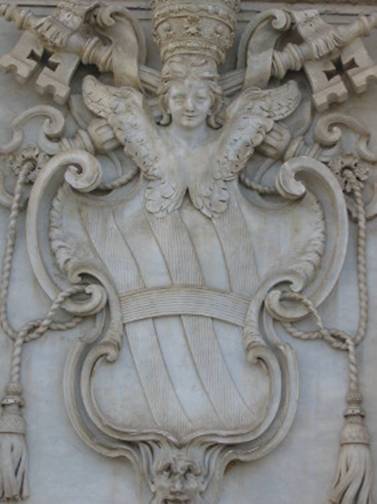
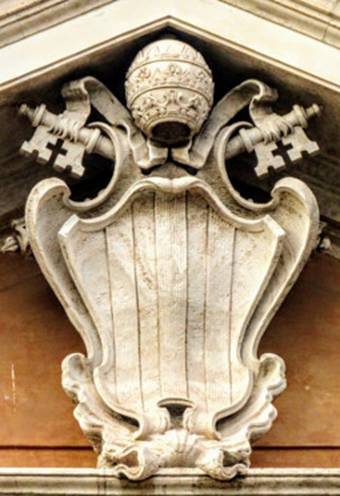
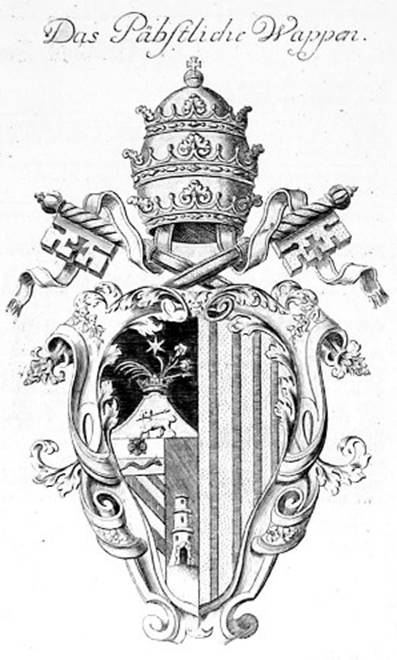
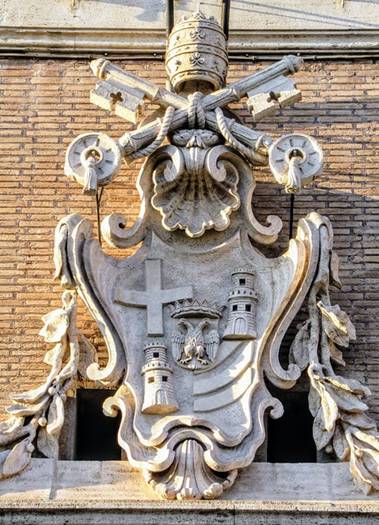
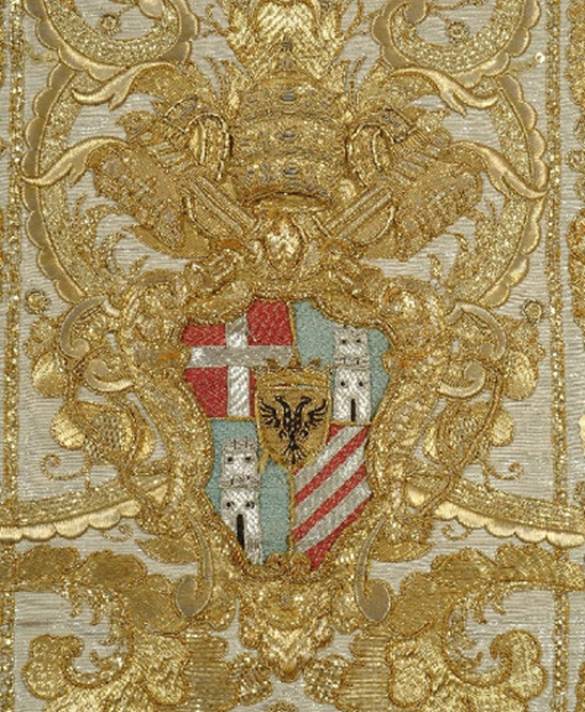
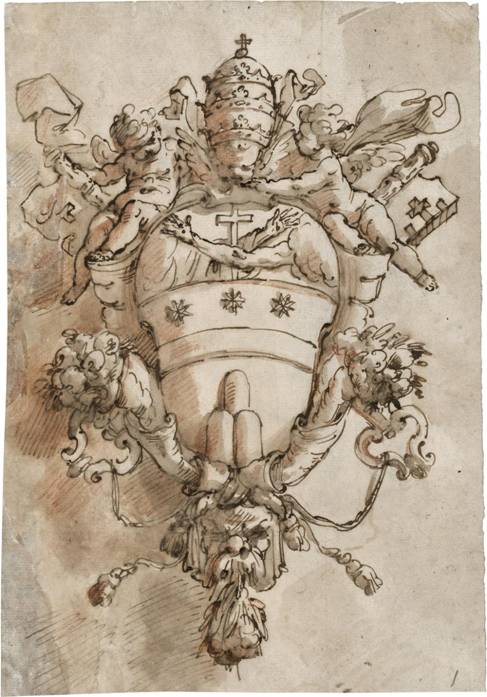
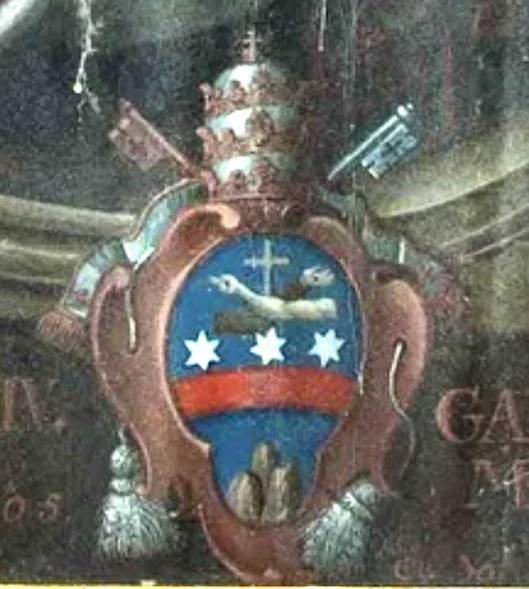
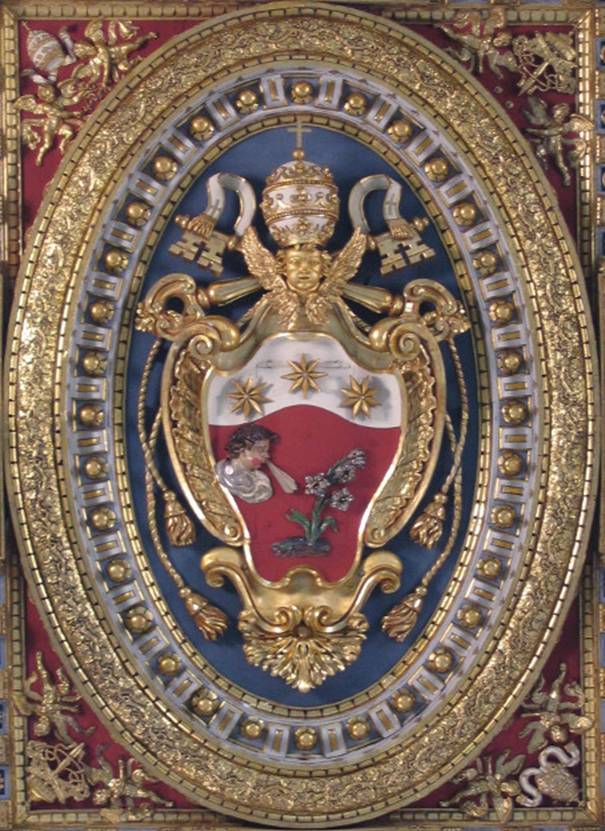
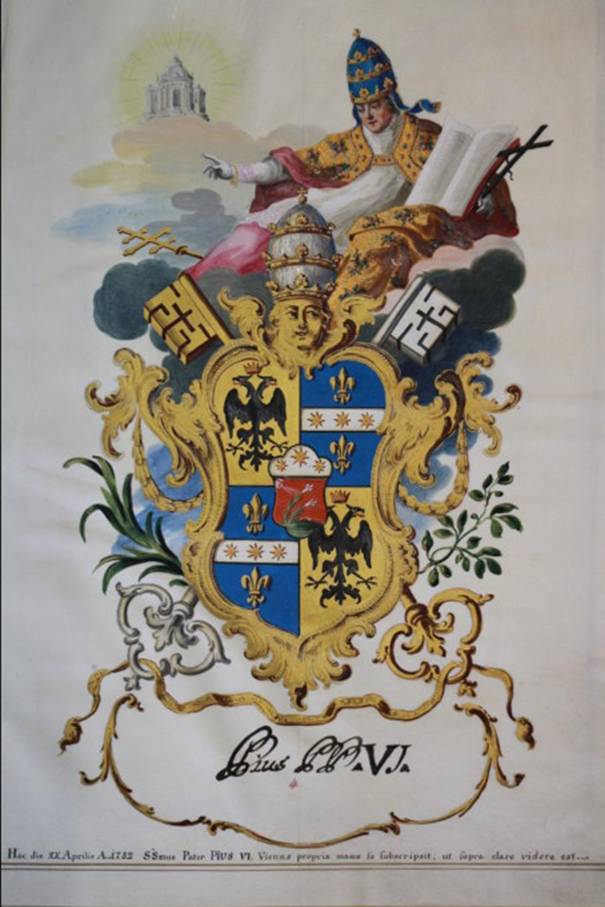
 Heraldry of the World
Heraldry of the World